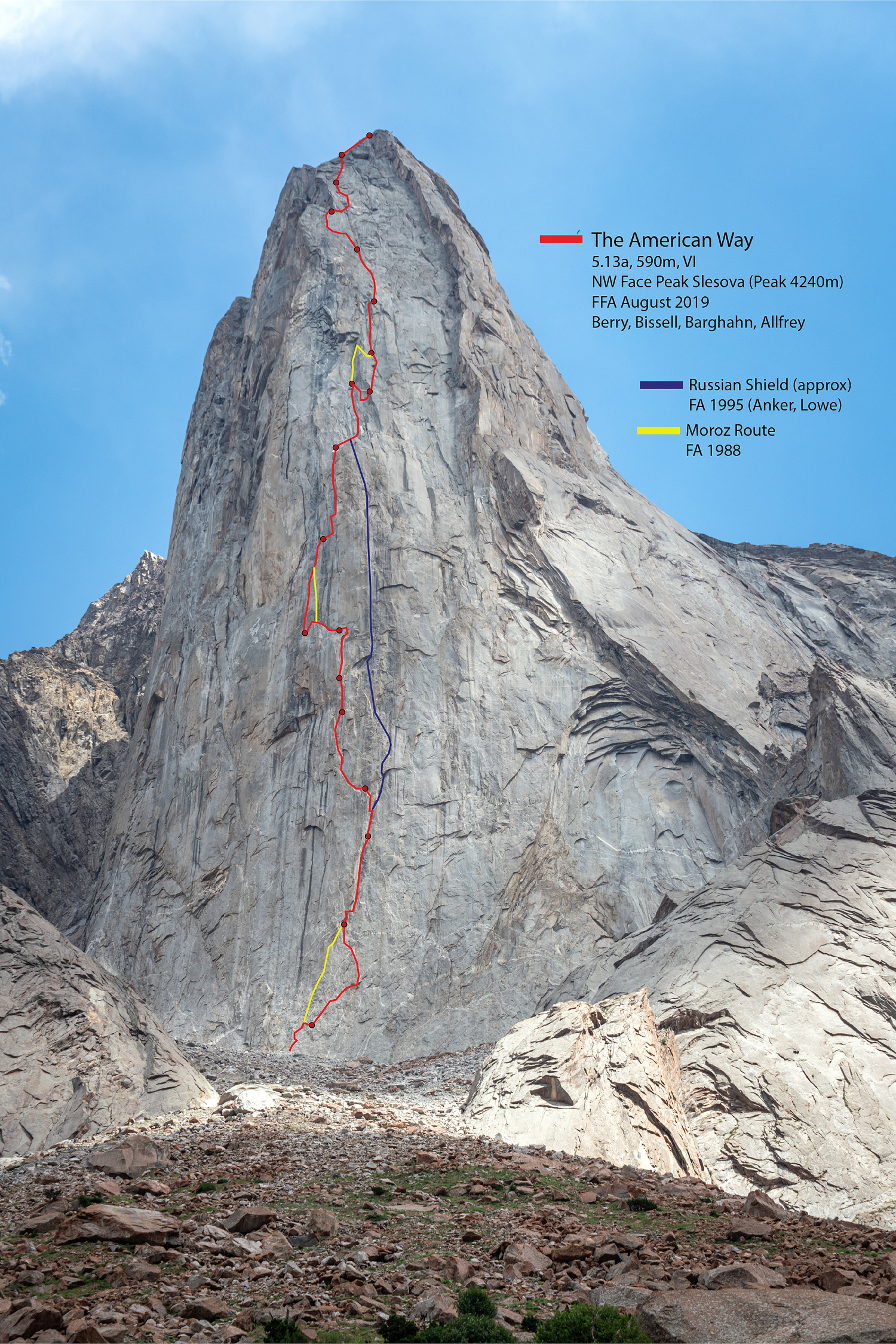The American Way: The free ascent of Pik Slesova's Northwest Face
Kyrgyzstan, Pamir Alai, Karavshin, Ak-su Valley

Pik Slesova (4,240m, a.k.a. Russian Tower) is an El Cap–size granite tower in the Ak-su Valley. Its southern aspect is home to one of the world’s great granite free routes, Perestroika Crack (5.12b), free climbed in 1995 by Greg Child and Lynn Hill. To the left, the steeper northwest face, first climbed in 1988, holds many Grade V aid routes, but had never received a free ascent. In 1995, on the same North Face expedition mentioned above, Conrad Anker and Alex Lowe climbed the face by a new route they named the Russian Shield. [This line was a substantial variation to the Moroz Route (1988), the original route up this face.] Subsequently, legend grew around the possibility of a magnificent and difficult free route up this very steep wall.
Following a week of travel, David Allfrey, Brent Barghahn, Nick Berry, and I arrived in the valley with a quadruple rack, 460m of rope (inclusive of lead lines), and 75 bolts. We brought a substantial number of bolts, knowing that the first couple of hundred feet of the wall is a blank slab, with minimal natural features. Our plan was to climb the aid line of the Moroz Route, the original route of the face, fixing lines as we went and sussing free passage. We planned to come back to base camp each day until we reached the halfway point on the wall, where a convenient ledge (the White Block Bivouac) was visible from the ground. We would then redpoint the pitches team-free, in order, and to our high point, before committing to the wall and climbing to the summit.
The first couple of pitches were a major question mark but revealed incredible face climbing. Pitch two (5.13a) didn’t have anything harder than V5, but was long and sustained. The next two pitches were unreal 5.12+, with pitch four in particular exemplifying the brilliant climbing of the route. At one point it was necessary to transfer from chimneying to compression climbing on a hanging arête, using toe hooks for a final crack transfer. Aside from the bolt ladders on pitch one and two, only a few additional bolts were needed to link features higher on the wall. Plus, bolts were added at belays.

Above the lower slab was a large feature with an ominous gaping crack on its right side. The Kyrgyz Monster, named after the Monster Offwidth on El Cap, had looked like fists from the ground, but we were happy to have brought our big green number 6 cam. The Russians had drilled a bolt ladder alongside this entire formation, so from our offwidth comfort we could push our number 6 and clip “bomber” 35-year-old Russian bolts.
The Kyrgyz Monster was the fork in the road where we thought the Russian Shield and the original route diverged. Tensioning to a mystery bolt right of our line, I looked up at the Shield cracks, hoping for a perfect challenge. Yet the seams I saw were undeniably small and steep. At this point, there was plenty of engaging and excellent climbing below us and a massive amount of terrain still above, so we opted to seek out the line of least resistance by following the Moroz Route to the summit.
After four days of aid climbing and three of free climbing, with trips back to base camp in between, we were established at the White Block Bivouac. Just above was some terrifying climbing, the loosest of the route. It treated us to nightmare sleeps while the wind whipped, and we imagined house-of-cards flakes slicing through our down sleeping bags. To avoid one major hazard 60m above the bivouac, we did a downward traverse along a dike of bone-white stone. Funky 5.12+ hand-foot down-mantels slanted to a ledge out right, from which we could finally access the lower-angled upper wall.
On our last climbing day, we redpointed the downclimb and then started sprinting our way up 70m pitches. The wall went on and on, and just as it got dark and started to snow, we pulled onto the broken summit. Tired and cold, we took a dark summit selfie and rappelled to White Block Bivouac. The next day we pulled all our ropes and gear off the wall (leaving rappel anchors) and descended the familiar ankle-busting talus to base camp. All told, we spent 18 days of August in the Ak-su, naming our free variation the American Way (950m, VI 5.13a).
Early on, we realized the climbing was quite special, and we decided to leave a route that others could enjoy repeating. So we were delighted to hear a few weeks after leaving the valley that a French party, our neighbors in base camp, had repeated the line and said it was one of the best routes they had ever done, with inspiring free climbing. Our team would certainly agree.
– Eric Bissell, USA




